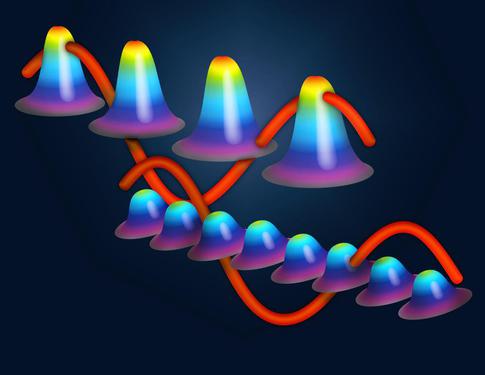XFEL: Shaping attosecond waveforms
Shaping attosecond waveforms

Scientists have been able to shape the electric field of an attosecond light pulse. Illustration: Jürgen Oschwald and Carlo Callegari
Chemical reactions and complex phenomena in liquids and solids are determined by the movement and rearrangement of electrons. These movements, however, occur on an extremely short timescale, typically only a few hundred attoseconds (1 attosecond =10-18 s or one quintillionth of a second). Only light pulses of a comparable duration can be used to take snapshots of the dynamics of electrons. An international team of researchers led by Guiseppe Sansone from the University of Freiburg and including scientists from European XFEL have now, for the first time, been able to reliably generate, control and characterize such attosecond light pulses from a free-electron laser.
"These pulses enable us to study the first moment of the electronic response in a molecule or crystal," explains Sansone. "With the ability to shape the electric field enables us to control electronic movements - with the long-term goal of optimising basic processes such as photosynthesis or charge separation in materials.”
The results have been published in the scientific journal Nature. They open up new approaches for controlling the electronic dynamics in real time, enabling thereby, for example, the study of chemical reactions at X-ray free-electron lasers and the development of electronic devices much faster than those currently used.
The experiment was performed at the seeded Free-Electron Laser FERMI in Trieste, which offers the unique capability to synthesize radiation with different wavelengths in the extreme ultraviolet spectral range with fully controllable relative phases.
Prof. Serguei Molodtsov, Scientific Director at European XFEL said: “The generation and use of attosecond X-ray pulses is under intense discussion at European XFEL and within the scientific community as a possible option for future use at new experiment stations. In this context these results are very important and exciting, since they show that it is possible to enable attosecond science at free- electron lasers.”
Further reading:
Press release from the University of Freiburg "Shaping Waveforms"
Original article:
Maroju, P.K., Grazioli, C., Di Fraia, M. et al. Attosecond pulse shaping using a seeded free-electron laser. Nature (2020). doi.org/10.1038/s41586-020-2005-6
